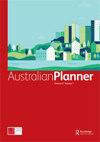Suburban densification: unpacking the misalignment between resident demand and investor-driven supply of multi-unit housing in Sydney, Australia
IF 1.5
Q2 Social Sciences
引用次数: 2
Abstract
ABSTRACT In market societies, investors have played a key role in driving suburban densification. However, the concentration of one- and two-bedroom apartments in suburban town centres has raised concerns about the potential mismatch between investor-driven supply and consumer demand. Despite these criticisms, analysis of consumer demand for multi-unit housing rarely considers housing supply in the same locality. Recognising the significance of multi-unit dwellings in housing supply, this paper develops a clearer understanding of consumer demand and market supply of multi-unit dwellings in suburban town centres. In order to integrate consumer preferences and housing data, the paper combines qualitative analysis of the housing preferences of a group of (largely) migrant women with children living in apartments in the suburban town centre of Liverpool, Sydney, Australia, with quantitative analysis of household type, apartment size and dwelling approvals. In so doing, we show that market-led supply creates a mismatch between housing need and type, as housing careers move beyond detached homes towards spacious apartments in suburban town centres. We conclude that calibrating the share of larger apartments in Local Government Development Control Plans with consumer demand will improve housing outcomes in densifying suburbs.郊区密集化:解开澳大利亚悉尼居民需求和投资者驱动的多单元住房供应之间的错位
摘要在市场社会中,投资者在推动郊区人口密集化方面发挥了关键作用。然而,一居室和两居室公寓集中在郊区市中心,引发了人们对投资者驱动的供应和消费者需求之间潜在不匹配的担忧。尽管有这些批评,但对多单元住房消费者需求的分析很少考虑同一地区的住房供应。认识到多单元住宅在住房供应中的重要性,本文对郊区城镇中心多单元住宅的消费者需求和市场供应有了更清晰的了解。为了整合消费者偏好和住房数据,本文将对居住在澳大利亚悉尼利物浦郊区城镇中心公寓中的一群(主要是)有孩子的移民妇女的住房偏好的定性分析与对家庭类型、公寓规模和住房批准的定量分析相结合。在这样做的过程中,我们表明,市场主导的供应造成了住房需求和类型之间的不匹配,因为住房职业从独立住宅转向郊区城镇中心的宽敞公寓。我们得出的结论是,根据消费者需求调整地方政府发展控制计划中较大公寓的份额,将改善密集郊区的住房效果。
本文章由计算机程序翻译,如有差异,请以英文原文为准。
求助全文
约1分钟内获得全文
求助全文

 求助内容:
求助内容: 应助结果提醒方式:
应助结果提醒方式:


